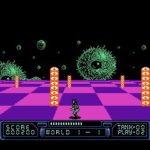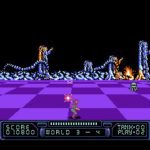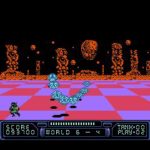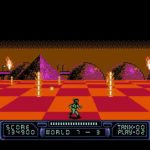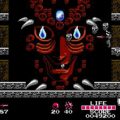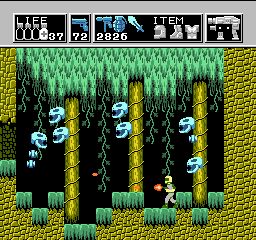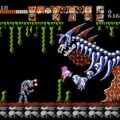Developer: Square Publisher: Square Release: 12/07/87 Genre: Action
3-D World Runner was not a personal favorite of mine but I could at least appreciate what it was trying to do. It could have been a great game if not for some baffling design choices such as a ridiculous difficulty curve. At this point it would not be surprising if most remember it for its goofy 3d mode than its gameplay. In America it was a one off. But in Japan it had a sequel the same year called JJ: Tobidase Daisakusen Part II. JJ is literally more of the same. But the execution is better and is less frustrating making it a decent purchase.
While this is technically a sequel in terms of gameplay it is virtually identical to the first game. What that means is you are essentially playing Space Harrier except instead of flying you can jump extremely high. You find power-ups such as missiles, invincibility and shields by running headfirst into massive columns. I never thought about it before but that sounds really dumb. The structure is also the same, with eight levels separated into four stages followed by a free roaming boss battle. It is disappointing that nothing else has been added to the game. However the refinements in gameplay and presentation make this the better of the two titles.
You can consider JJ 3-D World Runner’s dark cousin, the one that went away and is now goth. The bright colorful worlds of the original are no more. In their place are sinister planets that gets sell the devastation across the solar system. In many ways despite being different genres this resembles Square’s own Rad Racer 2. While the change in art is most apparent in screenshots what is not evident is the game’s speed.
JJ is fast. I would even go so far as to say too fast. 3-D World Runner already moved at a brisk pace that was annoying to deal with. I do not see why the designers felt the need to go even further in that direction honestly. No one can say the World Runner is not in a rush to save the universe. Unfortunately this affects the gameplay. Unless you have lightning reflexes there is no point in even bothering. The columns that produce power-ups fly by so fast you will likely spend more time without weapons or armor. Despite the increased speed the levels are about the same length as the original.
It sucks that the speed nearly ruins the game as my main gripe with the first game is better. They dial back the insane difficulty curve of the original as it is now more gradual. Those familiar with 3-D World Runner will remember being literally thrown to the wolves as the game expects master level technique early on. We are talking leaping on poles and changing speed in midair to land on multiple platforms. These elements were fairly early which was unfair. They still exist but do not show up until the later stages of the game where they feel appropriate. It is true that the faster pace can be difficult to handle. Personally that was not a deal breaker as I was able to manage with practice.
While I have mentioned the change in art style from an all-around standpoint this is a much more technically accomplished game which is surprising as it was developed in less than a year. The game is incredibly fast for an NES title yet there is no slowdown or flickering sprites. It beats the pants off the Famicom version of Space Harrier, that’s for sure. I do miss the variety and color of the first game as the dystopian setting can be a bit tiring. Doubly so as it also applies to the strange creatures inhabiting each world. That however is my own personal preference.
In Closing
At the end of the day despite the subtle gameplay improvements JJ: Tobidase Daisakusen Part II is still exactly like its predecessor. If it didn’t grab you the first time there is probably nothing here that will make you a fan this time around. As for myself I liked what 3-D World Runner tried to do and this turned out far better in my opinion and is worth a purchase.


